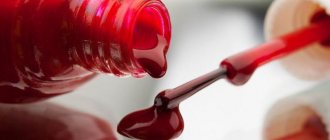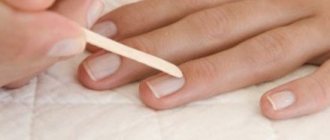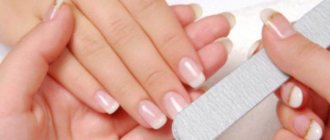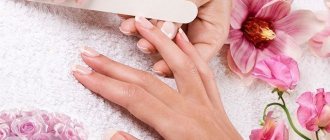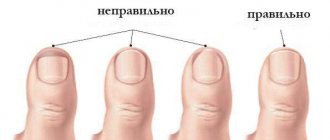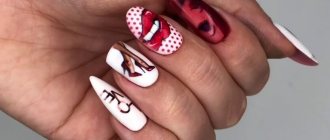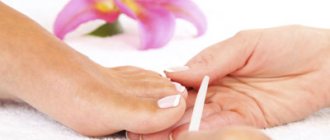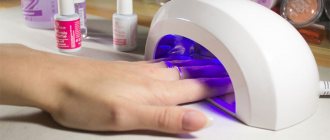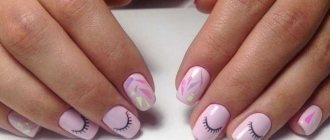A neat look to a manicure is given not only by the shape of the nails, the artificial coating, but also by a neat, moisturized cuticle. Unfortunately, to keep her healthy and well-groomed, it is not enough to visit a manicurist once a month. It is necessary to care for it daily at home.
In this article we will look at why it is so important to monitor the condition of the cuticle and what cuticle care products to use so that it looks healthy and does not spoil the appearance of your manicure and nail plate. Yes! The health of your nails depends on its condition.
What is a cuticle and why should you care for it?
The cuticle is a leathery roller that frames the matrix (the base of the nail plate). It performs a protective function, preventing the penetration of bacteria, infection, and dirt into the growth zone.
The cuticle consists of two parts. The upper part is called the eponychium. It is visible to the naked eye, and this is what we are used to calling the cuticle. The lower part is the pterygium. This is the keratinized layer of the cuticle, which also performs a protective function. It grows along with the nail plate and consists of whitish plates, films that are located under the cuticle and lateral sinuses. Partial renewal of the cuticle occurs in 14 days, complete renewal in 21 days.
The main principle of cuticle care is: “Remove dead cells and moisturize living ones.”
Why is regular care so important? The overgrown cuticle begins to dry, tear, and crack. All this causes the appearance of burrs. And they not only spoil the appearance of the manicure, but also cause pain. In addition, pathogenic bacteria and infection can get into the wounds, and then inflammation will begin.
In this case, the visit to the manicurist will have to be postponed and the treatment performed first, since:
- It will be difficult for both the master and the client to perform a manicure procedure on reddened, painful areas;
- If the inflamed cuticle is regularly injured, suppuration may begin, and then medical attention will be required.
If wounds do appear on the cuticle and they bleed, then it is necessary to use hydrogen peroxide, baneocin or a disinfectant hemostatic agent. And then use healing drugs. This is necessary in order to avoid inflammation.
As mentioned above, the health of your nails depends on the condition of the cuticle. As it grows, the growth of the nail plate slows down, and grooves and other irregularities may appear on it.
In addition to the lack of regular care, there are several other factors that negatively affect the condition of the cuticle and can lead to its damage:
- Incorrect use of the tool during manicure can lead to injury to the cuticle. To avoid mistakes, we recommend taking a manicure course;
- working with someone else’s tools that have not been disinfected;
- allergic reaction;
- habit of biting nails;
- work in an aggressive environment: in water, with chemicals.
Recommendations for cuticle care
To avoid problems with the cuticle, you need to regularly care for it: nourish and moisturize the skin, remove the stratum corneum. Are you visiting a manicurist? Great! But, unfortunately, this is not enough for complete care. Between visits to the master, the cuticle needs to be constantly given attention. Let's figure out what procedures and means will help achieve her healthy state at home.
Take baths and push back cuticles
Baths are necessary to soften the cuticle and prepare it for subsequent processing. Pour water at a comfortable temperature into a small container. You can add sea salt, a drop of essential oil or herbal infusion to it. After taking a bath, it would be a good idea to use a scrub to remove dead skin cells.
Then you need to use a metal pusher or an orange stick to push back the cuticle. Do this with light movements, avoid strong pressure, otherwise you may accidentally injure the cuticle or nail plate. You need to push back the cuticle about once a week.
Important!
For those who communicate with manicure tools on a first-name basis, it is better to use an orange stick. If you lack the skills, using a metal pusher can inadvertently injure your nail plate or cuticle. Do you want to master all the subtleties of manicure? Then sign up for courses at ParisNail school
Don't forget about hand massage
Hand massage:
- improves blood circulation;
- softens the skin, makes it firm and elastic;
- has a beneficial effect on the condition of the cuticle;
- slows down the growth of skin around the nail plate;
- accelerates nail growth;
Hand massage is very simple. Every girl can handle this.
- Apply a small amount of oil or cream to your hands;
- Rub the product in a circular motion with light pressure until it is completely absorbed.
Use cuticle oil
Cuticle oil is a must have for every girl! The oil perfectly moisturizes the skin and saturates it with vitamins. Use it daily, for example before bed. Place a drop of oil on the cuticle of each nail and massage well.
Please note that there are mineral and natural oils. Mineral oil forms an invisible film on the surface of the cuticle. If you use this oil every day, you will get the opposite effect - the cuticle will begin to dry out. This oil is more suitable for masters - the client comes for a manicure once every 3-4 weeks, and mineral oil is ideal for single use. At home, on a daily basis, it is better to use natural oil, such as Dadi Oil nail oil.
Olive, apricot or almond oils are also suitable for cuticle care. If desired, you can even make an oil blend and/or add a couple drops of essential oils.
Use hand cream
Such a simple recommendation that girls sometimes forget about. The cream must be present in daily care. In summer it will protect the skin from the scorching sun, in winter from frost, in autumn and spring from wind.
It can be moisturizing, nourishing, protective, restorative. Choose a cream based on your skin's needs and environmental conditions. For example:
- In winter, before going outside, use a protective cream;
- in summer, use a moisturizer containing SPF filters;
- and before going to bed, it is best to smear your hands with nourishing cream.
You can even use several creams at once: one in the morning and another in the evening.
Spa treatments
Oils and creams are not everything.
Once every 1-2 weeks, scrub and perform paraffin therapy. Do you think that only a professional manicurist can handle this procedure? You are deeply mistaken! Because paraffin cream was invented a long time ago, which is simply ideal for use at home.
Let's look at the technology for using such a cream.
- Thoroughly scrub your hands to remove dead skin cells.
- Apply a moisturizing or nourishing cream and rub it in well.
- Apply a thick layer of paraffin cream.
- We put on plastic gloves and do not take them off for 15-20 minutes.
- After the specified time has passed, remove the gloves and wipe off the remaining paraffin cream with a paper towel.
After the procedure, it is advisable not to wet your hands for two hours.
You can also use various hand masks and make wraps. Such procedures will not only improve the condition of the skin, but also lift your spirits.
Drink water
Don’t forget the well-known phrase: “A person is 80% water” and be sure to follow a drinking regime so that your skin, and therefore the cuticle, does not experience a lack of fluid. The daily water consumption rate is calculated using a very simple formula: 30 ml of water per 1 kg of weight.
Use gloves
To protect your skin from the aggressive effects of chemicals and water when cleaning the house, washing dishes, or working, be sure to wear household gloves. Going outside in cold, windy, frosty weather? Again, don’t forget about gloves, but regular ones.
So, the main rule of cuticle care is: “Remove, protect, moisturize.” Remember that the cuticle needs daily care. Only in this case will your hands have a well-groomed and attractive appearance!
Unedged method
The safest option for cuticle processing is the untrimmed or European method. No cutting objects are used in the process, so the risk of injury and infection is minimal.
Cuticle treatment without nippers:
- Hand bath. You need to pour water at about 38-40 degrees into a small container. Add liquid soap to it, 1-2 tbsp. l. sea or regular table salt. If necessary, you can add a few drops of your favorite essential oil. The procedure should last about 10 minutes.
- Drying hands. After the bath, wipe your skin and nails dry. A paper towel is suitable for these purposes.
- Applying remover. To remove cuticles, a special product is used that is applied to the skin around the nails.
- Cuticle removal. Dead particles will begin to “dissolve” under the influence of the remover. The softened skin can be carefully removed with a pusher or an orange stick. The main thing is not to make excessive efforts, but to work with the tool as carefully as possible, pushing the skin towards the base of the nail.
Attention! If the package with the remover contains information that the product must be washed off your hands, you should wash your skin and nails with warm water and detergents.
How to save money on manicure?
Do you want to perfectly master the art of manicure from A to Z and never spend 2,000-3,000 rubles in a salon again? Then learn how to do a manicure yourself and save money, time and nerves!
Come to our School for an online course from top teacher Tatyana Svoboda “Manicure for yourself,” which can now be completed for only 499 rubles !
The teacher will tell you all about the technique of applying the coating, removing it, modern designs, how to strengthen your nails, and much more. You will become a real pro and will be able to create your dream nail designs, and, if you wish, monetize your hobby in the future!
Course bonuses:
We give all students a 15% discount on ready-made manicure starter kits, as well as a 5% discount on purchases at ParisNail and 15% on any other online course. Upon completion of the training, you will be issued an electronic certificate of completion of the course.
How to remove cuticle at home - preparation
Before removing the cuticle, you need to prepare your hands. To do this, dip your fingers (or better yet, your hands) into a container of hot water. A little sea salt is first dissolved in the water; it has a disinfecting and softening effect on the skin of the hands.
If desired, add a few drops of essential oil or a teaspoon of vegetable oil to the water. Lemon essential oil is suitable for whitening nails, tea tree - for inflamed skin or minor scratches, grapefruit - for weak, dull nails.
It is recommended to add almond oil or jojoba oil for dry skin on hands and brittle, brittle nails. The bath for fingers and hands takes 15-20 minutes, after which the palms are wiped dry with a soft towel. Well, then they begin to directly remove the cuticle.
